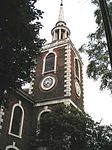Thames Tunnel

The Thames Tunnel is a tunnel beneath the River Thames in London, connecting Rotherhithe and Wapping. It measures 35 feet (11 m) wide by 20 feet (6 m) high and is 1,300 feet (396 m) long, running at a depth of 75 feet (23 m) below the river surface measured at high tide. It is the first tunnel known to have been constructed successfully underneath a navigable river and was built between 1825 and 1843 by Marc Brunel and his son Isambard using the tunnelling shield newly invented by the elder Brunel and Thomas Cochrane. The tunnel was originally designed for horse-drawn carriages, but was mainly used by pedestrians and became a tourist attraction. In 1869 it was converted into a railway tunnel for use by the East London line which, since 2010, is part of the London Overground railway network under the ownership of Transport for London.
Excerpt from the Wikipedia article Thames Tunnel (License: CC BY-SA 3.0, Authors, Images).Thames Tunnel
Rotherhithe Street, London Rotherhithe (London Borough of Southwark)
Geographical coordinates (GPS) Address Nearby Places Show on map
Geographical coordinates (GPS)
| Latitude | Longitude |
|---|---|
| N 51.503 ° | E -0.052 ° |
Address
Sunshine Weekly The Pilgrims Pocket
Rotherhithe Street
SE16 4NQ London, Rotherhithe (London Borough of Southwark)
England, United Kingdom
Open on Google Maps










